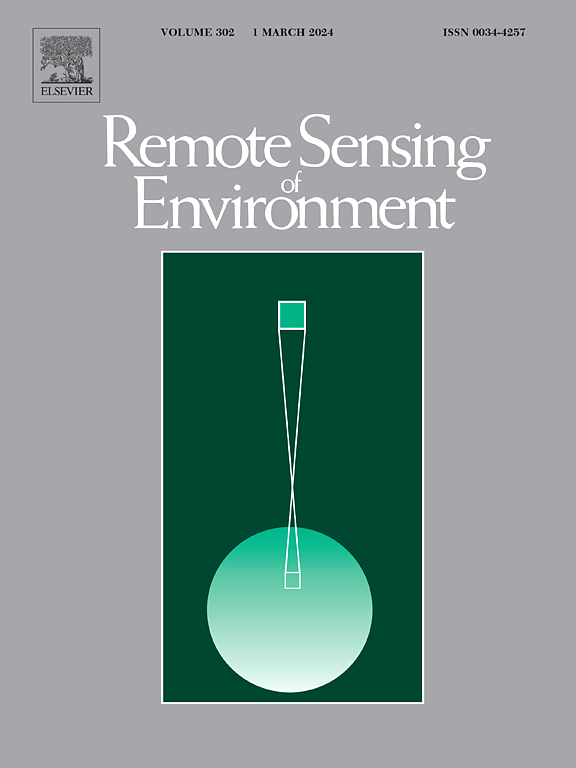基于梯度的非等温混合像元的非线性多像元物理分离方法
IF 11.1
1区 地球科学
Q1 ENVIRONMENTAL SCIENCES
引用次数: 0
摘要
组分温度和辐射率是了解植物生理和城市热动力学的关键。然而,现有的热红外解混方法在同时检索和多组分分析方面面临挑战。我们提出了基于离散各向异性辐射传输模型(TRUST-DART)的亚像元温度和发射率的热遥感解混,这是一种基于梯度的多像元物理方法,可以同时从城市地区的非等温混合像元中分离出组分温度和发射率。TRUST-DART利用DART模型,需要输入包括地面辐射图像、下沉天空辐射、带有组件分类的3D模型和标准DART参数(例如空间分辨率和天窗比例)。这种方法产生组件发射率和温度的图。利用先进星载热发射和反射辐射计(ASTER)图像和模拟的伪ASTER图像,利用植被和城市场景对TRUST-DART的精度进行了评估。结果表明,残余辐射误差约为0.05 W/(m2·sr)。在不存在共配准和传感器噪声误差的情况下,发射率的残差中值约为0.02,温度的残差中值在1 K以内。这种新方法大大提高了我们分析城市地区热特性的能力,为城市环境监测和规划提供了潜在的突破。TRUST-DART的源代码随DART一起发布(https://dart.omp.eu)。本文章由计算机程序翻译,如有差异,请以英文原文为准。
A gradient-based nonlinear multi-pixel physical method for simultaneously separating component temperature and emissivity from nonisothermal mixed pixels with DART
Component temperature and emissivity are crucial for understanding plant physiology and urban thermal dynamics. However, existing thermal infrared unmixing methods face challenges in simultaneous retrieval and multi-component analysis. We propose Thermal Remote sensing Unmixing for Subpixel Temperature and emissivity with the Discrete Anisotropic Radiative Transfer model (TRUST-DART), a gradient-based multi-pixel physical method that simultaneously separates component temperature and emissivity from non-isothermal mixed pixels over urban areas. TRUST-DART utilizes the DART model and requires inputs including at-surface radiance imagery, downwelling sky irradiance, a 3D mock-up with component classification, and standard DART parameters (e.g., spatial resolution and skylight ratio). This method produces maps of component emissivity and temperature. The accuracy of TRUST-DART is evaluated using both vegetation and urban scenes, employing Advanced Spaceborne Thermal Emission and Reflection Radiometer (ASTER) images and DART-simulated pseudo-ASTER images. Results show a residual radiance error is approximately 0.05 W/(m2·sr). In absence of the co-registration and sensor noise errors, the median residual error of emissivity is approximately 0.02, and the median residual error of temperature is within 1 K. This novel approach significantly advances our ability to analyze thermal properties of urban areas, offering potential breakthroughs in urban environmental monitoring and planning. The source code of TRUST-DART is distributed together with DART (https://dart.omp.eu).
求助全文
通过发布文献求助,成功后即可免费获取论文全文。
去求助
来源期刊

Remote Sensing of Environment
环境科学-成像科学与照相技术
CiteScore
25.10
自引率
8.90%
发文量
455
审稿时长
53 days
期刊介绍:
Remote Sensing of Environment (RSE) serves the Earth observation community by disseminating results on the theory, science, applications, and technology that contribute to advancing the field of remote sensing. With a thoroughly interdisciplinary approach, RSE encompasses terrestrial, oceanic, and atmospheric sensing.
The journal emphasizes biophysical and quantitative approaches to remote sensing at local to global scales, covering a diverse range of applications and techniques.
RSE serves as a vital platform for the exchange of knowledge and advancements in the dynamic field of remote sensing.
 求助内容:
求助内容: 应助结果提醒方式:
应助结果提醒方式:


